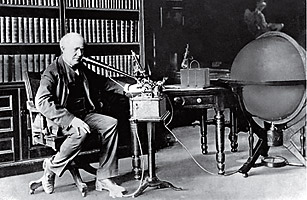
The inventor in 1912 with what he called the Edison Business Phonograph
In the end, they named it the phonograph. But it might have been called the omphlegraph, meaning "voice writer." Or the antiphone (back talker). Or the didasko phone (portable teacher). These are some of the names someone wrote in a logbook in Thomas Edison's laboratory in 1877, after Edison and his assistants invented the first rudimentary machine for recording and playing back sounds. From the first, they thought it would be used to reproduce the human voice, but they had no clear idea of its exact purpose.
Edison once said, "Anything that won't sell, I don't want to invent." But all his life, he was a better inventor than salesman. The phonograph, his first invention to make him world-famous, is a perfect example. It was the product of a well-prepared but wandering mind.
It was also the outcome of an amazing burst of inventiveness. One evening in July 1877, while relaxing with his assistants after their regular midnight dinner, Edison had an idea. They were working with ways to use paper strips to make a record of telegraph messages. Why not adapt those to record the vibrations of the diaphragm in a telephone mouthpiece? Thinking out loud, Edison suggested attaching a needle to the back of the diaphragm and mounting it above rollers for the paper strips. Speaking into the mouthpiece would cause the diaphragm to move, which in turn would cause the needle to inscribe squiggled indentations into the strips. If the paper were then pulled through the rollers again with the needle resting in the groove, the indentations would move the attached diaphragm, which should reproduce the original sound.
Edison's assistants set to work. Within the hour, they had a working device they tried out by reciting "Mary had a little lamb" into the telephone. In the first trial, all that could be heard from the playback was "ary ad ell am." But that was encouraging. The staff went on working through the night, fiddling with the gizmo — and thus occurred the first midnight recording session.
Edison and his crew later replaced the paper and rollers with tinfoil, which was wrapped around a cylinder attached to a crank. But Edison did not regard the machine as commercially promising. At best, he thought, it might be an office machine allowing businessmen to dictate letters.
When word of the invention spread, however, the outside world saw greater possibilities. The dead could speak to us, eternally! Collectors could keep what the New York Times called a "well-stocked oratorical cellar." But the primitive phonograph that Edison demonstrated for the editors of Scientific American that December remained exceedingly limited. It could clearly introduce itself — "How do you do? How do you like the phonograph?" — but that exhausted its recording capacity.
Still, the editors were excited enough to publish an admiring bulletin about the device — a first shot that set off an avalanche of publicity. A reporter wrote him, "I want to know you right bad," and everyone else did too. Investors enlisted him in a new venture, the Edison Speaking Phonograph Co. But he soon lost interest in making the phonograph a salable product. The company introduced a toy model that functioned badly and a second, more expensive one that was used by show-business entrepreneurs who rented concert halls to demonstrate the wondrous machine to paying audiences. It broke down frequently and required a trained technician's constant attention.
Ten years elapsed before Edison returned to the phonograph, only after a competitor developed a wax-coated cylinder that could be removed without ruining the recording, something impossible to do with Edison's delicate tinfoil. To him, the idea that his most cherished invention faced competition was unendurable. He set to work on what he would call the Perfected Phonograph. When he introduced it to the market, however, in 1889, it was anything but perfect as the dictation device he still thought it to be. But it played music beautifully. Edison's backers tried to persuade him that the phonograph could be marketed for entertainment purposes, but he could not let go of his conviction that it was destined for the office.
Competitors leaped further ahead, developing a new recording medium, the disc, and rushing to sign musical artists to recording contracts. Eventually, Edison capitulated and entered the recorded-music business too — a business he was poorly suited to as a man who disapproved of most genres of popular music. He dismissed "miserable dance and ragtime selections" and described jazz as something for "the nuts." Another competitor soon emerged, the Victor Talking Machine Co. and its Victrola. And while Victor built a stable of notable musical artists, Edison remained unwilling to pay royalty advances necessary to recruit stars.
In the 1920s, Edison's phonograph faced a new challenge, commercial radio. The other phonograph companies introduced radios but Edison refused, wanting nothing to do with the medium's inferior sound quality. Prodded by his sons, he grudgingly relented, but the move came too late — in the midst of the stock-market crash of 1929. Within a year, his radio company ceased production. Edison died a year later. The music industry he had set in motion lived on, evolving into stereo, iPods and streaming music. He had made it all possible, without ever quite grasping how to make the most of it for himself.
Stross is the author of The Wizard of Menlo Park: How Thomas Alva Edison Invented the Modern World